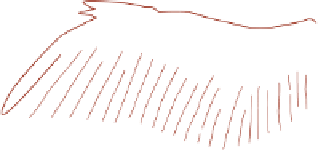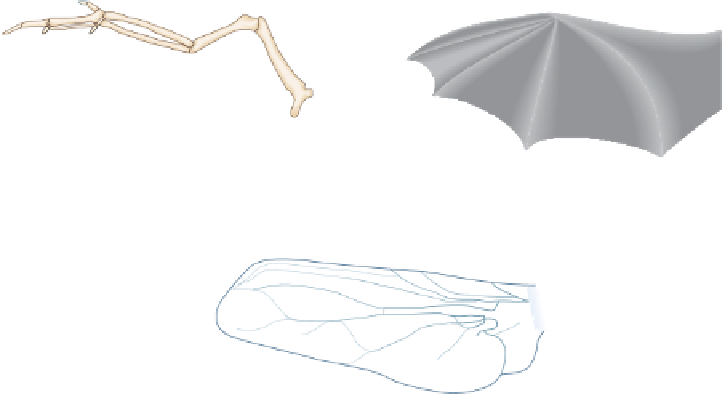Geology Reference
In-Depth Information
Bird
Bat
◗
Figure 18.15
Analogous Structures The fl y's
wings serve the same function as wings of birds
and bats, so they are analogous, but they have a
different structure and embryologic development.
Fly
Another type of evidence for evolution is observations
of small-scale evolution in living organisms. We have already
mentioned one example—the adaptations of some plants to
contaminated soils. As a matter of fact, small-scale changes
take place rapidly enough that new insecticides and pesti-
cides must be developed continually because insects and
rodents develop resistance to existing ones. And develop-
ment of antibiotic-resistant strains of bacteria is a continuing
problem in medicine. Whether the variation in these popula-
tions previously existed or was established by mutations is
irrelevant. In either case, some variant types lived and repro-
duced, bringing about a genetic change.
◗
Figure 18.16
Vestigial Structures
We h a v e d e fi ned
fossils
as the remains or traces of organisms
preserved in rocks, and noted that they are useful for deter-
mining environments of deposition (see Chapter 6) and are
used for relative age determinations (see Chapter 17). The
term
body fossil
applies to actual remains such as bones, teeth,
and shells, whereas a
trace fossil
is an indication of organic ac-
tivity, such as burrows and tracks. Preservation of body fossils
takes place in several ways (Table 18.3 and see Geo-inSight on
pages 488 and 489), and fossils in general are quite common,
although the chances of some organisms being preserved
are much better than for others. In fact, the fossil record is
strongly biased toward organisms with durable skeletons that
live in areas where burial is likely. Accordingly, marine inver-
tebrates such as clams and corals are better represented in the
fossil record than bats, birds, worms, and jellyfi sh.
Fossil marine invertebrates found far from the sea, and
even high in mountains, led early naturalists to conclude
that the fossil-bearing rocks were deposited during a world-
wide fl ood. In 1508, Leonardo da Vinci realized that the fos-
sil distribution was not what one would expect from a rising
fl ood, but the fl ood explanation persisted and John Wood-
ward (1665-1728) proposed a testable hypothesis. According
to him, the density of organic remains determined the order
in which they settled from fl oodwaters, so, logically, fossils
in the oldest rocks should be denser than those in younger
ones. Woodward's hypothesis was quickly rejected because
observations did not support it; fossils of various densities
are found throughout the fossil record.
Dewclaw
Notice the dewclaw, a vestige of the thumb, on the forefoot
of the dog.
a
2
ankle bone
The Eocene-age whale
Basilosaurus
had tiny vestigial back limbs,
but it did not use limbs to support its body weight. Even today,
whales have a vestige of a pelvis, and on a few occasions, whales
with rear limbs have been caught.
b























Search WWH ::

Custom Search